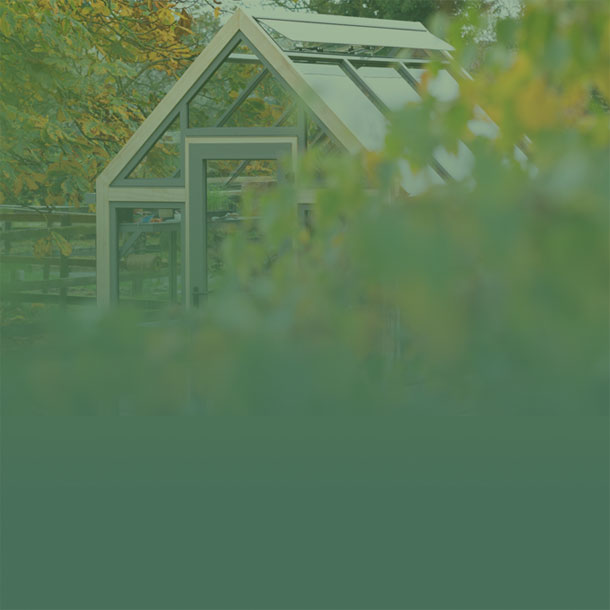-

5 Essential Greenhouse Accessories
21st June 2013 • General • Stephanie DonaldsonWhen it comes to kitting out your greenhouse you can end up spending a small fortune. Let’s take a look at the essential bits of equipment to help you set up your greenhouse in the right way.
Greenhouse Staging
Every greenhouse should have a bench from which to work. When choosing staging there’s primarily three types available :
 Slatted staging – Perhaps the most popular as it is both lightweight and cheap to make as it uses less material than other staging types. Slatted staging allows free drainage and also permits air to pass between the slats which helps keep the greenhouse cool on warm days. Ventilation is crucial in not only keeping the greenhouse cool but also reducing pests and diseases.
Slatted staging – Perhaps the most popular as it is both lightweight and cheap to make as it uses less material than other staging types. Slatted staging allows free drainage and also permits air to pass between the slats which helps keep the greenhouse cool on warm days. Ventilation is crucial in not only keeping the greenhouse cool but also reducing pests and diseases.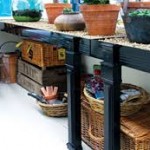 Solid staging – As the name suggests such staging will have a solid surface. This is often in the form of a tray which can be filled with pea gravel. Consequently solid staging can be useful for retaining a level of moisture which helps to cool the greenhouse as well as providing a moist environment favoured by a number of plant types.
Solid staging – As the name suggests such staging will have a solid surface. This is often in the form of a tray which can be filled with pea gravel. Consequently solid staging can be useful for retaining a level of moisture which helps to cool the greenhouse as well as providing a moist environment favoured by a number of plant types.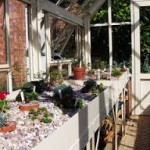 Plunge staging is most commonly used for growing alpines. In this instance the staging usually has a 9 inch deep tray which is filled with sand. Since Alpine plants grow best in conditions where their roots are kept cool the plunge staging help simulate this environment in that the pots can be partially or fully buried in the sand so as to keep them cool.
Plunge staging is most commonly used for growing alpines. In this instance the staging usually has a 9 inch deep tray which is filled with sand. Since Alpine plants grow best in conditions where their roots are kept cool the plunge staging help simulate this environment in that the pots can be partially or fully buried in the sand so as to keep them cool.Size
When measuring up for staging first consider it’s position within the greenhouse. Usually staging runs down the length of the structure. You should opt for as wide as you can and in this regard there are two points to consider :
- How far across it can you reach ? For example will you be able to reach across it to open the side vents of the greenhouse ?
- The staging should not extend so far into the greenhouse that it goes beyond the width of the door.
In the instance you can set the height of the staging you should aim to put it so that staging surface is 500mm above the floor. To put this in context a typical kitchen worktop is 600mm high. Why so low ?
When your staging is in use it should be full of pots and seedtrays – the top of these will likely be nearer a standard worktop height. Bare in mind that you’ll have to water these regularly and holding a watering can high up for any length of time may prove difficult.Shelving
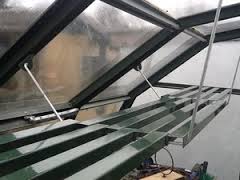 Like staging, greenhouse shelving is particularly useful. It is most commonly placed directly above the staging below the eaves of the greenhouse. This usually gets warmer that the staging due to its proximity to the roof glass and is consequently often used to germinate seeds in seed trays. If you plan to use your greenhouse shelving for pots then you should allow ample space between the top surface of the shelf and the eaves. Shelving is often slatted and most widths can accommodate a seed tray which is 34cm wide.
Like staging, greenhouse shelving is particularly useful. It is most commonly placed directly above the staging below the eaves of the greenhouse. This usually gets warmer that the staging due to its proximity to the roof glass and is consequently often used to germinate seeds in seed trays. If you plan to use your greenhouse shelving for pots then you should allow ample space between the top surface of the shelf and the eaves. Shelving is often slatted and most widths can accommodate a seed tray which is 34cm wide.Shading
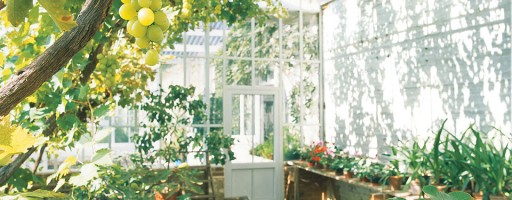
Photo courtesy of Hartley Botanic
There are a number of options for shading your greenhouse which range in price. At the cheaper end you could opt to whitewash your greenhouse during the warmest months of the year. Equally inexpensive but requiring patience and ongoing maintenance is to plant a vine which can be trained to provide some natural shade (with the advantage that it also provides grapes).
Then there’s the option of retractable roller blinds. These are usually fitted internally and can be utilised when hot and sunny and retracted on cooler cloudier days. Whilst such blinds provide important shade they do not stop the warmth from the sun penetrating the greenhouse. Consequently the greenhouse can get very hot. In the instance that you want to cool as well as shade the greenhouse then consider external shading. A number of suppliers provide external blinds that are either permanently fixed during the summer months or retractable. In either instance if you’re expecting windy weather you should perhaps consider taking them down until the wind dissipates. As you might expect external blinds will deteriorate over time.
Autovents
Keeping your greenhouse ventilated is vitally important. A well ventilated greenhouse will help keep your plants cool (or alive!) on warm days but it will also assist in reducing plant disease. If you are not around on a daily basis then autovents are a godsend. Relatively cheap and extremely effective an autovent can be fitted to almost any vent.
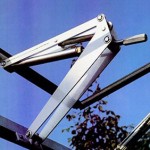 The autovents respond to changes in temperature, the warmer the temperature the wider they open. They require no electricity. A cylinder filled with mineral wax is the key to how they work. As the wax warms it expands which in turn pushes out a piston. In the evening as the temperature cools the wax contracts, the piston retracts, and the window closes. Genius !
The autovents respond to changes in temperature, the warmer the temperature the wider they open. They require no electricity. A cylinder filled with mineral wax is the key to how they work. As the wax warms it expands which in turn pushes out a piston. In the evening as the temperature cools the wax contracts, the piston retracts, and the window closes. Genius !Greenhouse Heaters
Depending on how you intend to use your greenhouse a heater can be invaluable. Most commonly they are used to keep the temperature of the greenhouse above freezing throughout winter. There are two types of greenhouse heaters :
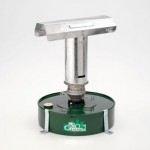 Parafin – cheap and effective but requiring careful maintenance and attention.
Parafin – cheap and effective but requiring careful maintenance and attention.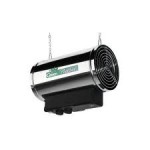 Electric Fan heaters – most come with a thermostat which allows them to start up when a certain minimum temperature is breached. These have the added advantage of being used as a fan to circulate the air in the summer. As you might expect these are more usually more expensive to run and will require a power source within the greenhouse.
Electric Fan heaters – most come with a thermostat which allows them to start up when a certain minimum temperature is breached. These have the added advantage of being used as a fan to circulate the air in the summer. As you might expect these are more usually more expensive to run and will require a power source within the greenhouse.

